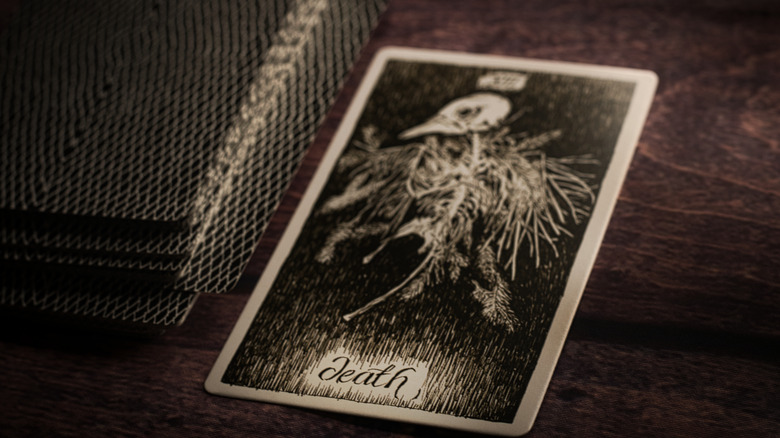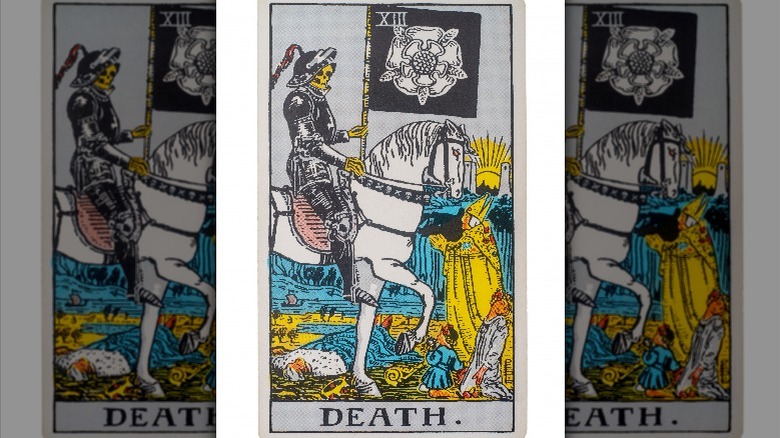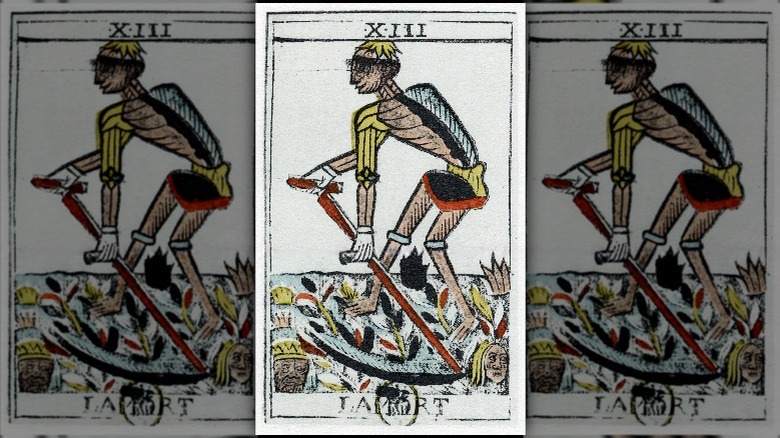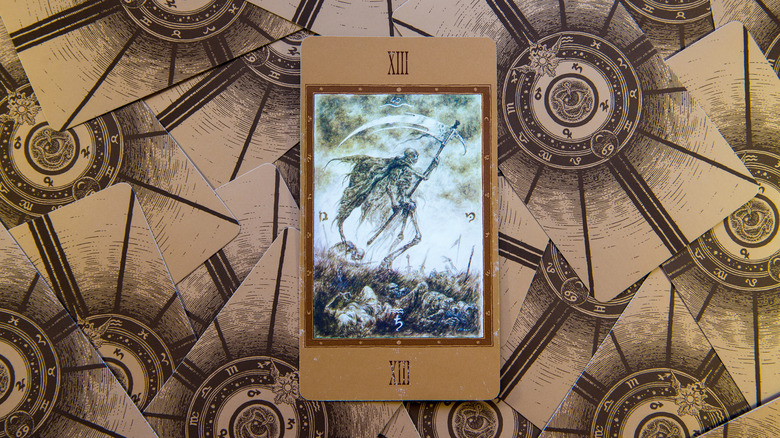What Does The Death Card Mean In Tarot? (Hint: It's Not As Scary As It Sounds)
It probably sounds menacing, but fear not when it comes to the Death card in a tarot reading. Seeing the grim reaper or another morbid illustration on a card pulled for you from a tarot deck doesn't mean that the grim reaper is actually coming for you. But there is an indication that things will be coming to an end for you in some capacity — just not exactly in the way your imagination may concoct when you're face to face with a physical representation of death.
The Metropolitan Museum of Art has tracked the history of tarot cards back centuries from the modern day and discerned the origins of various cards found in tarot cards that have been in continuous use since the 15th century. In historic decks of tarot cards, there was a routine order of importance of cards pulled for individuals seeking guidance. The Death card has a history of being the fifth most important card in tarot decks, with cards representing the sun, moon, stars, and temperance — in respective order — leading in the hierarchy before the Death card.
In spite of this importance, or perhaps because of it, seeing the Death card in a reading might feel a bit daunting. But whether you're an experienced tarot card reader, you seek out regular readings, or you're new to the world of tarot and want to learn more, here is all that you should know about the Death card and why it isn't a card you should fear.
Understanding the illustrations on the Death card
Modern tarot card decks often have Death cards with illustrations of the grim reaper, but they also frequently have depictions of skeletons on horseback. Biddy Tarot describes common Death card imagery as possessing black armor-clad skeletons sitting atop a white horse, which is an image nearly as menacing as the grim reaper. However, readers (or recipients of readings) are advised not to jump to dreadful conclusions and to maintain an open mind should the Death card be pulled from the deck during a tarot reading.
Instead of representing mere demise, the skeleton on a Death card is actually indicative of the physical body that remains following death, while the white horse accompanies the given fact of death with purity, power, hope, and strength. Essentially, the message is that even though death cannot be avoided, there remains beauty and strength in the endings of chapters and the beginnings of new narratives. You cannot be alive without death, and you cannot face death if you haven't been alive — so in many ways, the Death card is sensitively poetic and serves as a reminder of our ability to live our lives to the fullest.
Of course, there are two ways that a Death card can be pulled from a tarot deck — upright and reverse — with the orientation of the card being just as significant as the meaning of the card itself. So what does that mean for your reading?
When the Death card is pulled upright
Pulling the Death card might seem intimidating, but don't fret, particularly if pulled upright. A Little Spark of Joy offers the reassurance that while many people have fears of the Death card appearing on their behalf, the card is a symbolic one and can actually signify a positive transformation in your life. When pulled upright, the Death card in a tarot deck may indicate that a situation that no longer serves you is being removed from your life so that new beginnings can flourish in its place. An upright Death card can also symbolize a current or upcoming transition that might be tumultuous at the time of its occurrence, but will ultimately create positive new starts within your life.
Other associations with an upright Death card can be impending endings to toxic cycles within relationships, work, or even within your inner dialogue if your self-talk has become a limiting factor for you. In this case, the Death card might symbolize a powerful force or significant movement in your confidence, relationships, or endeavors. If there is something in your life that has been holding you back and causing distress, the Death card can be an indication that the toxic energy is about to dissipate and be replaced with a shift toward something new. In many ways, since the ominously perceived card represents the end of burdensome situations and dynamics, pulling an upright Death card is like a sigh of relief rather than a moment of panic.
A reversed Death card requires self-awareness
While an upright Death card is indicative of changes happening within your life, usually with influence from external factors, a reversed Death card pulled on your behalf speaks more to your internal struggles with change and letting go. There is heavy emphasis on a person who receives a reversed Death card resisting change, whether it's a one-time instance of not wanting to let go of what is familiar or a lifelong habit of denying the ever-changing ways of the world. Often, a person for whom a reversed Death card is pulled is not only afraid or resistant to change in their lives at present, but they are also panicked or even threatened by the thought of new beginnings, per A Little Spark of Joy. If a Death card is pulled in reversed orientation on your behalf, the symbolism is directed at a need for you to look inward at your own hesitations, resistances, and tendencies to allow negative or toxic patterns to repeat due to a fear of letting go.
Biddy Tarot encourages people who receive reversed Death cards to look at any needed internal purging of behaviors, mindsets, or narratives that are preventing positive changes from occurring. A reversed Death card is an opportunity to explore personal transformation and look inward through self-reflection. Think of it as an urging from the universe to take chances on letting go of old habits (letting them "die") so that new opportunities can flourish.



